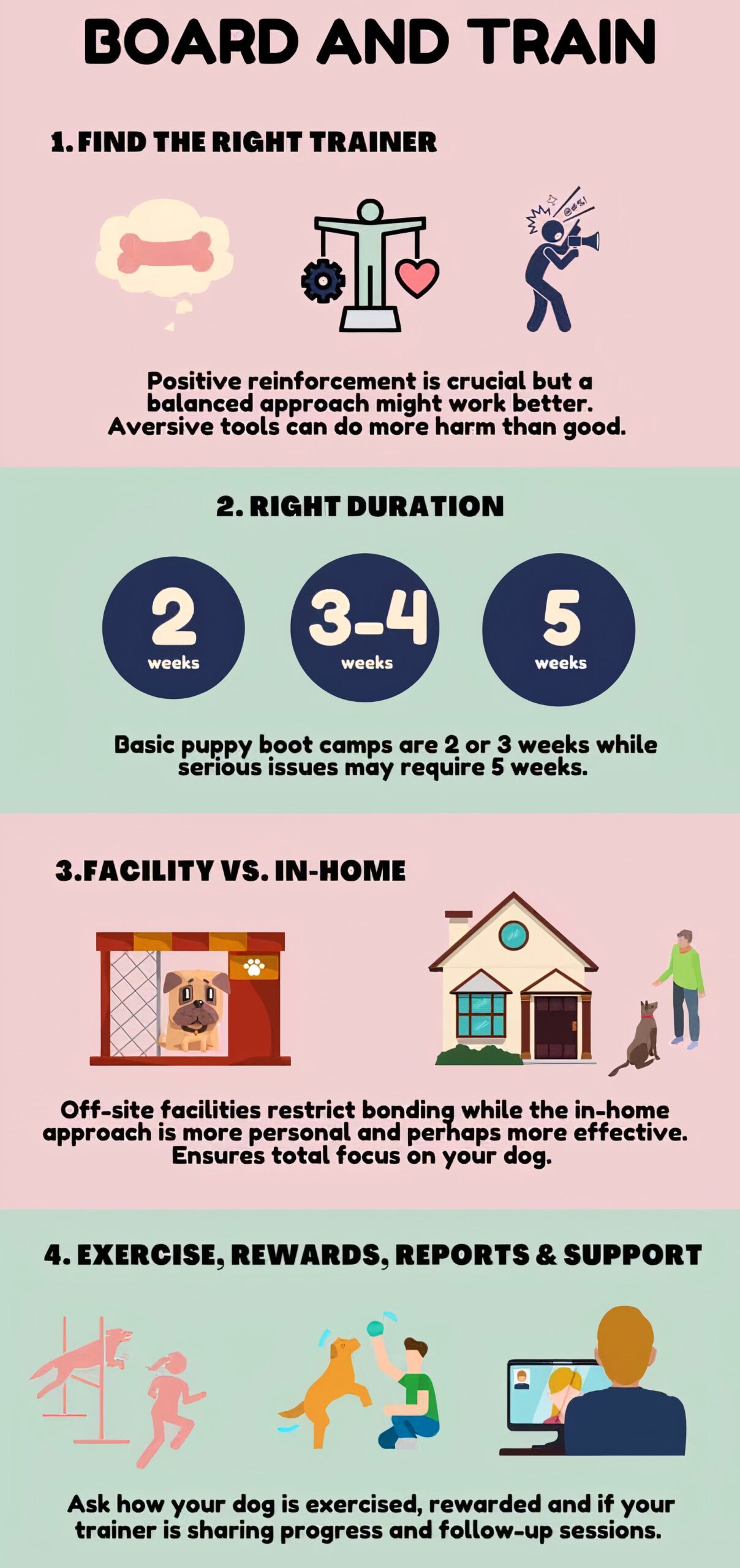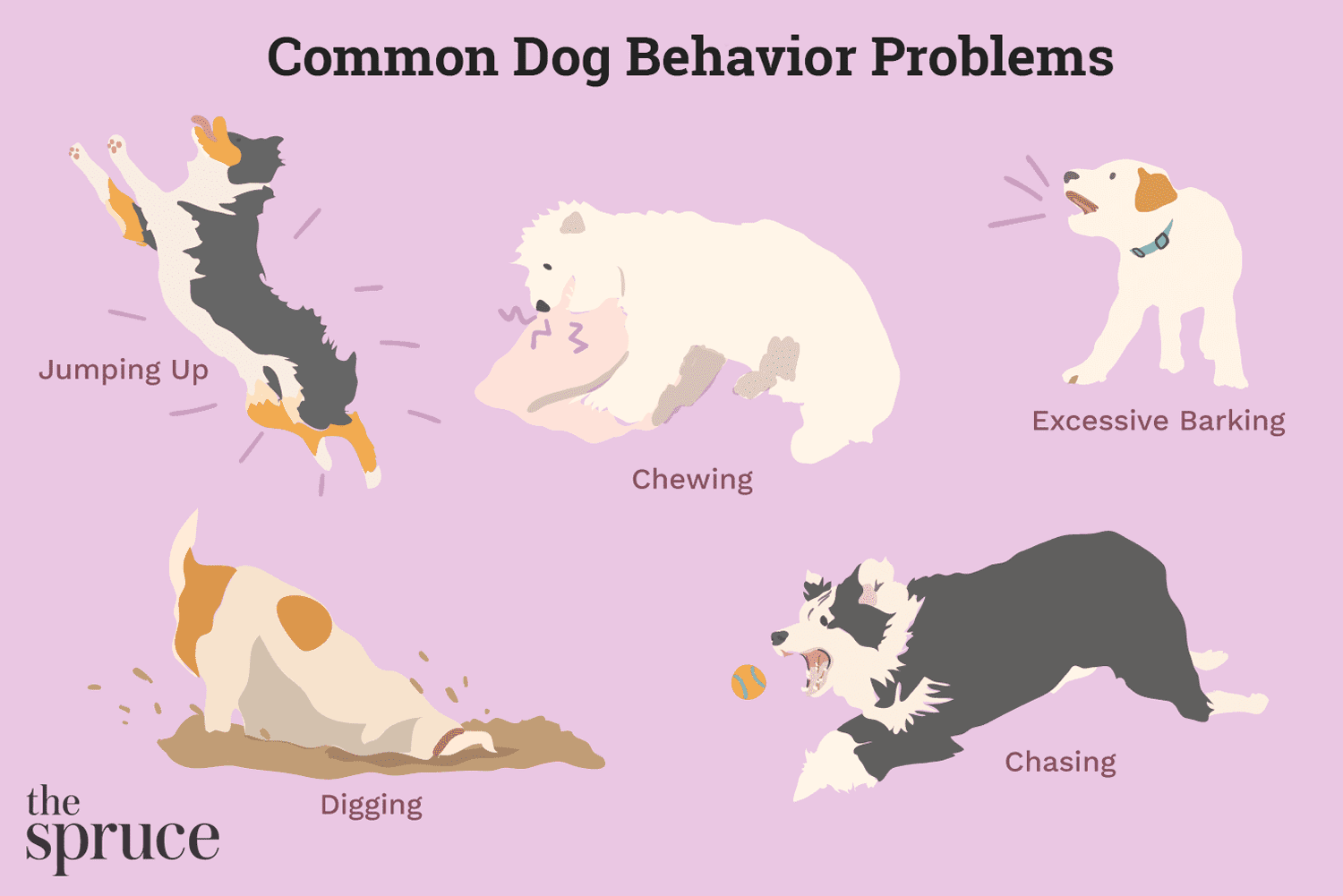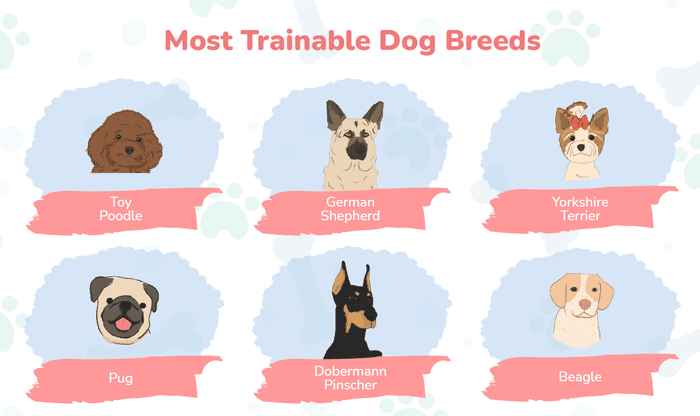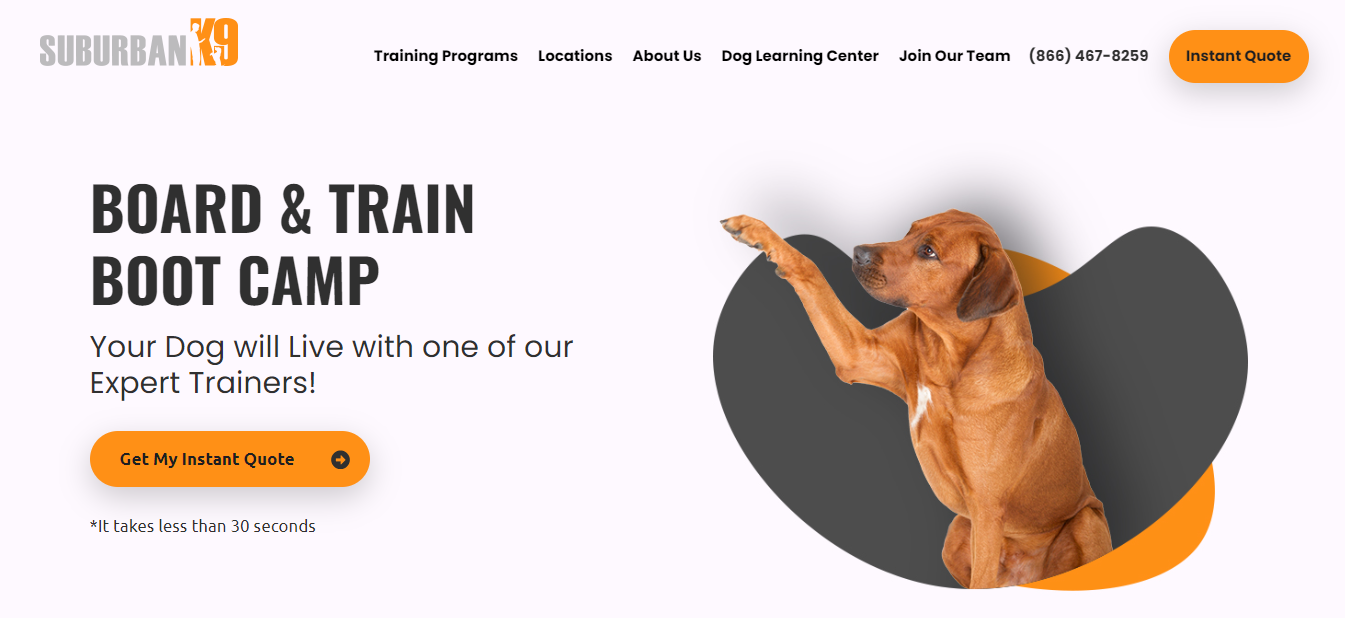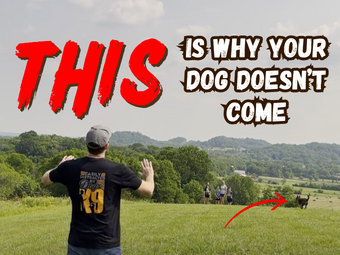Welcoming a dog into your life is a wonderful experience. Think of all the puppy eyes and slobbery kisses. But those slobbery kisses and cuddles are all fun and games until you have to teach your new puppy how to “house”. The board and train program comes out as the silver lining for all those who can’t cope with the pressures of training their puppies at home.
Board and train programs are like finishing schools for dogs. It is where they'll learn all-important manners, tricks, and maybe even a little doggy diplomacy. No more endless YouTube tutorials or frustration-filled evenings struggling with stubborn behavior. But, of course, the key is getting hold of the right program for your dog.
While you may find many board and train programs around you, there are tricks to discovering the best one out of the lot.
Read our article to learn everything about board and train programs. You’ll know how to bag one that offers the best training at the most competitive price because it’s never too late to see your dog move around with social grace.
What Is A Board And Train Program For Dogs
The board and train dog training programs are pretty much what they sound like – they are professional dog training programs where your dog goes to stay at a specialized facility for a certain period. During their stay, they receive intensive training from skilled trainers for basic obedience, to address specific behavioral issues, or learn new commands.
So how long does your dog stay in one of these board and train programs? The typical duration is around 2 to 3 weeks but it can vary depending on your dog's needs, personality, and breed as well as the program curriculum. As for when to start – the sooner, the better. The younger they are, the more they can soak up all that good training stuff.
There are 2 types of board and train programs:
A. In-Home Board And Train: The Trainer's Place
It's a personalized doggy boot camp. In this setup, your dog goes to the trainer's home and becomes part of their family for a while. The best thing about in-house training is that your dog gets some serious one-on-one attention. The trainer tailors the training to your dog's specific needs and works on their training plan right in their home environment.
B. Facility-Based Board And Train: Training Central
In this type, your dog stays at a dedicated board and train facility. At these places, they have all the equipment, space, and expertise to train dogs like pros. Your dog gets to stay in a dedicated space within the facility – like a little dorm room. They interact with other dogs and learn in a controlled, structured environment.
Finding The Best Dog Board And Train Program Near You: 10 Crucial Factors To Consider
So now you have decided it's time to enroll your doggo in a board and train program, but with so many options, how do you pick the one that's just right? Well, we are helping you find the best fit for your dog. Let's discuss the 10 key factors you should consider when picking the board and train program.
1. Reputation & Reviews
When it comes to finding the right board and train dog training program for your furry friend, start by checking out the program's reputation and reviews. Reputation is like a program's street cred.
Do they have a solid track record of successfully improving dogs' behavior and training? You can usually find this out by doing a bit of research online or asking fellow dog owners for recommendations. If a program has a good reputation, it's a good sign that their trainers know their stuff.
Look for feedback from people who enrolled their dogs in the program. What did they like? What didn't they like? Did their dogs benefit from the training? Websites, social media, and forums are great places to find these reviews. Pay attention to both positive and negative feedback because it can give you a well-rounded view of what to expect.
2. Trainer Experience & Qualifications
Now let's talk about the people behind the program – the trainers themselves. The trainer’s experience and qualifications are crucial factors to consider. You'll want to know how long the trainers have been working with dogs. Have they dealt with a variety of breeds and behavioral issues? More experience often means they've seen it all and know how to handle different situations.
Look for certifications or memberships in professional dog training organizations. These indicate a commitment to ongoing learning and adherence to industry standards. However, not all certifications are worth the paper they are printed on. So do a bit of research to make sure those credentials are the real deal. You wouldn't want to end up with a trainer who's all bark and no bite.
When you're considering a board and train program, don't be shy about asking for the trainers' credentials or even their success stories. A good program will be proud to share their trainer's qualifications and accomplishments.
3. Training Philosophy
The training philosophy is the program's guiding principle. Find a program that aligns with your beliefs about how your dog’s behavior should be shaped and how it should be trained.
Some programs use positive reinforcement which means they reward good behavior with treats, praise, or toys. Others might employ balanced methods that involve gentle corrections in addition to positive reinforcement. The key is to find a program whose training philosophy you are comfortable with.
Consider what approach you think will work best for your dog. Do you believe in rewarding good behavior and building a positive relationship with your pup? Or do you think a firmer approach might be needed for long-lasting results? Knowing your preferences will help you find a dog training board and training program that fits your dog's training needs and your values.
4. Facility & Environment
The setting can have a major impact on your dog's training experience. First, check out the facility. Is it clean, safe, and well-maintained? It should be a place where your dog feels comfortable and secure. Look for proper fencing, secure kennels, and a comprehensive training environment.
Some programs have dedicated training spaces designed to minimize distractions while others might train dogs in more varied settings to help them generalize their skills to real-life situations.
Consider what type of environment would be most beneficial for your dog's training needs. For instance, if your dog has severe behavioral issues, a controlled, distraction-free environment would be best. On the other hand, if you want your dog to learn to behave well in various situations, exposure to different environments during training could be key.
5. Training Duration
The training duration matters a lot because it affects both the effectiveness of the training and your dog's overall experience. Now these programs can last anywhere from a few weeks to a few months. It depends on what your dog needs and what kind of issues you want to tackle.
If your dog is relatively well-behaved and just needs a refresher, a shorter program might do the trick. But if your pup has some serious behavior problems or you're aiming for advanced training, you might want to go for a longer program.
Remember, a shorter program might mean a more narrowed focus on specific training areas while a longer one can ensure your dog gets a more comprehensive education – talk about deciding between a quick crash course or a full semester of learning.
6. Trainer-To-Dog Ratio
The trainer-to-dog ratio is directly proportional to the personalized attention your dog will receive during their training. A lower trainer-to-dog ratio means your pup gets more one-on-one time. That is helpful if your dog has some serious issues or needs personalized training.
On the other hand, a higher trainer-to-dog ratio can mean more group training. This can be great for socialization but your dog might not get as much individual attention.
When you're checking out board and train programs, ask about the trainer-to-dog ratio. If your dog needs intensive training, a lower ratio is the way to go. But if your dog's already a bit of a pro and just needs some fine-tuning, a higher ratio might work just fine.
7. Cost & Value
Let's talk dollars and cents. Cost is a big deal when it comes to picking a board and train program for your dog, but it's not just about finding the cheapest option. Think about the value you are getting for your money.
First, get a clear picture of what the program includes. Does the cost cover training, meals, and accommodation for your dog? Are there any hidden fees or additional charges you should know about? Check the fine print on a contract.
The program's reputation and the trainer's qualifications play a major role here as well. Sometimes, paying a bit more for an experienced trainer with a solid track record can be worth it in the long run. Consider it as an investment in your dog's education.
Also, think about what's important to you. Are you looking for quick results or are you more concerned about a specific training philosophy? Your priorities can help you determine what kind of value you are getting for the price.
8. References & Recommendations
Ask the program for references – people who've enrolled their dogs before. Hearing about their experiences can give you a better sense of what to expect. Did their dogs improve? Were they happy with the training?
Also, don't hesitate to tap into your dog-owner network. Ask friends, family, or even your veterinarian if they know of any good board and train programs. Personal recommendations can be golden. Take your time to gather this info. References and recommendations can help you make an informed decision about which program is the best fit for your dog.
9. Follow-Up Support
So you have got your dog back after they completed the board and train program and they are behaving like a superstar. But what happens next? Well, that's where follow-up support comes into play.
Follow-up support is the assistance you get from the program after your dog returns home. This could be in the form of additional training sessions, phone consultations, or even group classes.
So why is this important? Because dogs can sometimes revert to old habits or face new challenges once they are back in their familiar environment. Follow-up support helps you navigate these situations.
Ask the program about their follow-up support options. How long do they offer this support? What does it include? Having ongoing help can make the transition smoother for both you and your dog.
10. Guarantee & Refund Policy
Some programs offer a guarantee that your dog will achieve certain training goals. If your dog doesn't meet these goals within a specified time frame, they might offer additional training or even a refund.
It's important to understand what happens if you're not satisfied with the program. Do they offer partial or full refunds if your dog doesn't respond well to the training? What are the conditions for a refund?
Now it's crucial to be realistic. Not all dogs will have the same results and training success can depend on many factors, including your dog's behavior and your commitment to reinforcing the training at home.
Nevertheless, having a clear understanding of the program's guarantee and refund policy can give you peace of mind. It shows that the program stands behind its training methods and outcomes.
How Much Does A Board And Train Program Cost: 5 Factors That Influence Prices
On average, prices for a 2-week board and train programs range from $2000-$3500. However, this is a ballpark figure and can go higher or lower depending on different factors. In some high-cost areas, you might find prices well above these ranges, especially for longer, more comprehensive programs. Also, some programs might include follow-up sessions or group classes as part of the package while others may charge extra for these services.
Talking of factors, let’s break down the details of what makes those dog board and train programs cost what they do.
I. Location & Facility Amenities
The location and facility where your dog will be boarded and trained play a major role in determining the program's cost. Think of a big city versus a small town. If you are in a busy metropolis with a high cost of living, the prices for these programs are going up too. The dog trainers need to cover their own living costs and the overhead for their facilities.
Similarly, the fancier the facility, the more you'll pay. Places with climate-controlled kennels, fancy play areas, and high-tech security systems are going to charge a premium. You are essentially paying for the comfort and security of your dog while they're away from home.
II. Dog’s Breed
Different dog breeds have different temperaments and tendencies. Some are quick learners and eager to please while others may be more stubborn or independent. The breed's characteristics influence the complexity of the training required. For instance, a border collie might pick up commands more rapidly than a strong-willed bulldog. So the breed can affect both the duration and cost of the program.
III. Duration Of The Program
The length of your dog's stay in the program directly impacts the cost. If you are signing up for a quick 1-week boot camp, that's going to be less expensive than a 4-week behavioral overhaul.
Why the price difference? Well, trainers need time to work with your pup. Longer programs allow for deeper training and more consistent reinforcement. Plus, the extended stay includes boarding, food, and other care costs, which can add up.
Remember, your dog's unique needs and behavior will also play a role. If your furball has some stubborn habits or complex issues, it might take more time and effort to get things sorted out, which can bump up the price.
IV. Dog's Age
Puppies can be scatterbrained and have shorter attention spans so they need brief, more frequent sessions. On the other hand, older dogs may take longer to unlearn bad habits. So age can swing the duration and, therefore, the cost of the training.
Expert Advice: Starting training early is great because consistency really matters. But if you send a puppy to a board and train program before it hits 4 months, it might not get as much out of it as an older dog would.
V. Behavioral Issues & Goals
If your dog has specific behavioral issues like aggression, anxiety, or excessive barking, fixing them can be time-consuming and might require specialized training techniques. More intensive training and behavior modification can extend the program's length which increases the cost. If the program needs to be tailored to their specific issues, it can impact pricing.
Similarly, your training goals are a big player here. Do you just want the basics like sit and stay or are you aiming for Olympic-level canine skills? More advanced goals, like off-leash control or agility training, can mean a longer, pricier program. If you're going for something specialized like therapy dog certification, that's another layer of training and, you guessed it, more cost.
VI. Trainer's Experience & Expertise
Experience matters. But trainers with years of experience come at a higher price. Their extensive knowledge lets them handle different dogs and behavioral issues effectively. They've seen it all and know how to adapt their training methods to suit each unique dog.
A trainer's reputation in the dog training community can also impact their pricing. Highly respected trainers who achieved success in dog competitions, authored books, or appeared on television charge a premium for their services. Their reputation reflects their track record of producing well-trained dogs.
Another aspect to consider is the trainer's success rate. Trainers with a track record of turning challenging cases into well-behaved dogs charge more because they deliver results.
Suburban K9’s Board And Train Program: The Perfect Balance of Expertise & Affordability
At Suburban K9, we have a team of 42 skilled trainers who are all AKC-certified testers for titles. They've worked their magic on over 20,000 dogs. We are spread out across 21 locations all over the United States, so yes, we are pretty much everywhere!
Now here's the exciting part – our board and train program is tailor-made for you and your dog. It can last anywhere from 1 to 3 weeks, depending on what you and your pup need. We kick things off by asking you to fill out a little questionnaire – more of a doggie personality profile! This helps us understand your goals and your dog's unique quirks.
Once we've got the scoop, your pup gets to stay at one of our trainer's houses. During their stay, they'll master all the essential obedience commands: sit, heel, down, stay, and come. We also tackle common trouble spots like potty training, front door manners, leash pulling, excessive barking, and nipping and biting.
Now let's talk about our training philosophy. At Suburban K9, we are all about balance. Our training technique combines the best of both worlds: positive reinforcement and gentle nudges in the right direction. We believe that if you overload your pup with treats and go all-in on positive reinforcement, they'll never quite grasp the art of being calm and well-behaved.
Our balanced approach is like finding the sweet spot. It's about offering rewards when your dog does something right and giving them a gentle correction when they veer off course. It's all about encouraging those good behaviors and steering them away from the not-so-great ones.
We offer an extended dog training program known as "Dog Boot Camp Plus", which includes:
- A 2-week board and train session for your dog.
- 14 private lessons conducted right in the comfort of your own home.
- A 1-week refresher board and train session.
- Plus, you'll receive 2 extra follow-up lessons to ensure your pup's ongoing success.
Conclusion
From behavior modification to socialization and everything in between, board and train programs ensure that your dog gets the best training. They get to learn faster and more effectively since they work closely with expert trainers in focused training sessions.
So whether you have a mischievous pup who needs some guidance or just want to fine-tune your dog's manners, a board-and-train program is the way to go – and there is none better than Suburban K9’s.
At Suburban K9, we are all about making your dog's life – and yours – a whole lot easier. Our team of dedicated trainers is a dream team. They have the magic touch to turn even the most spirited dogs into well-behaved sweethearts. Book your free consultation now and let's get started on the journey to a happier, better-behaved dog.
The article above contains Affiliate Links from Amazon and other companies. If you visit their site and buy the product, we will get a small commission. Please know that we only recommend products we truly love and would never recommend a product we don't think is incredible. We look at and try hundreds of products before we ever recommend them to our clients!
